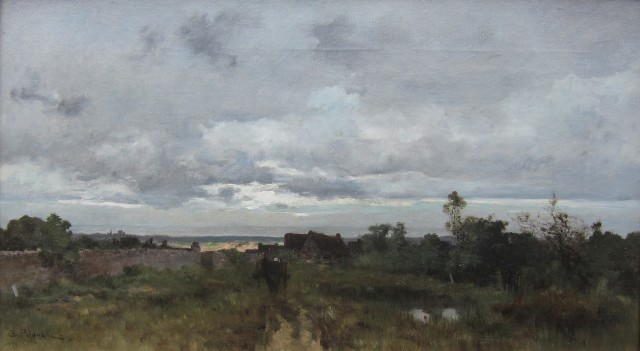Leon Germain Pelouse
(1839 – 1891)
Born in 1838 in Pierrelaye in the Seine-et-Oise region of France, near Paris. Rather than beginning a career as an artist, he began working at sixteen as a traveling sales representative in Roubaix. This work introduced Pelouse to the varying landscapes and villages in France. He also served in the military for a short term, before beginning his artistic pursuits. During his time in the military he executed his first painting in his quarters, after his colonel gave him permission to do so.
Pelouse never studied under any teacher and became his own master, a remarkable fact given that his paintings attained such success. Eugène Montrosier, in Les Artistes Modernes: Peintres de Genre (Paris: Libraire Ch. Tallandier, pg. 101), thought that he did indeed have a master and wrote:
One could write more about Mr. Pelouse who, without a master, by only the force of his determination, arrived after some years to take one of the top places among the modern landscape painters. To suggest that Mr. Pelouse did not have a master, is perhaps not correct. He did have one, sincere, profound, always varied, always moving: Nature!
For Pelouse, nature was perhaps the most significant influence on his work. He said, “The unfortunate thing for me…at the time when I was beginning, was that, having not worked in any atelier, I didn’t know any painter. I was even ignorant that landscape painters could cherish certain landscapes over others.” He moved to Vaux-de-Cernay in 1870, only to be driven out three months later by the invading Prussians. As the story goes, the Prussians ransacked the majority of the resident’s houses, save for Pelouse’s, whose house and studio they regarded with such wonder that they could not bring themselves to destroy the work inside. Once the Prussians retreated, Pelouse returned to Vaux-de-Cernay and devoted himself whole-heartedly to his work.
Pelouse’s relocation to Vaux-de-Cernay signals his further association with the other major landscape painters of the period, who, while working in other areas, especially Barbizon around the Forest of Fontainebleau, displayed the same interest in natural rendering of details in a landscape. Despite having no master himself, students were drawn to Pelouse’s residence in Vaux-de-Cernay, seeking his counsel and advice.
He debuted at the Salon of 1865 with Environs de Precy - Oise, souvenir d’automne (Near Precy - Oise, souvenir of autumn). His next two Salon entries, those of 1868 and 1869 were works inspired by the landscape in the Brittany region, especially Pont-Aven, where he spent time working and gathering ideas and finding himself attracted to the sea. In 1873 he earned his first medal, a second class award, for Vallée de Cernay (Cernay Valley). In 1876 he was given a first-class medal, “recompense which for thirty years had not been given to a landscape painter,” for Une coupe de bois à Senlisse - Seine-et-Oise (A Felling in the forest of Senlisse – Seine-et-Oise) and a second class medal at the Exposition Universelle of 1878 where he exhibited a number of works. This same year he was also given France’s highest honor when he was named Chevalier de la Légion d’Honneur. All of these works show Pelouse focusing intently on landscape painting in various regions around France, most notably those of Normandy and Brittany.
Pelouse’s final Salon showing was in 1890 where he exhibited Bords de Seine; l’Ile de Tribouillard (Banks of the Seine; the Tribouillard Island) and La Seine, à Poses; vue du barrage (The Seine, at Poses, view of the dam). The previous year he had exhibited at the 1889 Exposition Universelle where he earned a gold medal.
By the end of his career his style of landscape painting had been sufficiently accepted by the Salon juries that besides his awards, he served as a jury member seven times. He died on July 31, 1891 in Cernay. There is little doubt that his work helped maintain the importance of the landscape tradition, while shifting the focus to regions that Pelouse knew intimately and well.
Museums:
Metropolitan Museum of Art – Janvier, Cernay, près de Rambouillet (January, Cernay, near Rambouillet)
Musée d’Orsay – Grandcamp, vue de la plage (Grandcamp, view of the beach), Souvenir de Cernay (Souvenir of Cernay)
Quimper – Le Chemin de Rustephan (The Rustephan Path)
Carcassonne - Grandcamp, marée basse (Grandcamp, low tide)
Le Havre – Prairies Inondées, Brecehan (Flooded Prairies, Brecehan)
